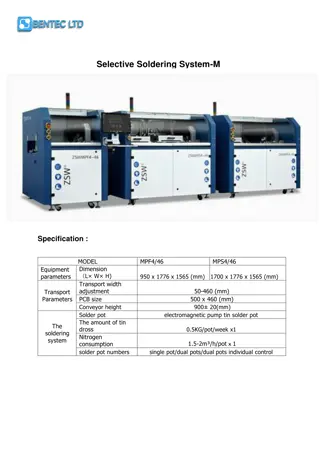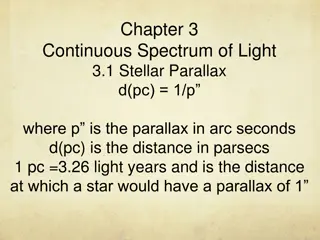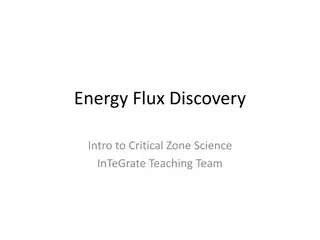Evolution of CT Scan Technology and Terminology
The development of CT scanning technology revolutionized medical imaging. Godfrey Hounsfield introduced computerized axial transverse scanning in 1972, with Allan Cormack's mathematical contributions. Dr. Robert Ledley created the first whole-body CT scanner in 1974. Dr. Willi Kalender further advan
1 views • 121 slides
SUR-TOITURE ET DOUBLE TOIT
Producing shade, reducing heat flux, and saving energy through the use of double roofs and over-roofs. Double roof systems involve installing a new roof over an existing one with proper insulation, while over-roofs create a protective layer above the original roof. These techniques significantly low
1 views • 11 slides
Understanding AGN Jet Production Efficiency: Insights from Spin and Magnetic Flux
A fundamental question in astrophysics is how efficiently active galactic nuclei (AGN) produce jets. Black hole spin and magnetic flux play crucial roles in determining the jet production efficiency. High-spin values and large magnetic flux threading are essential for generating high-efficiency jets
2 views • 22 slides
Understanding Oxygen Diffusion Rate Measurement in Plant Roots
Measurement of oxygen diffusion rate in plant roots is crucial for assessing soil oxygen levels and aeration conditions. The Oxygen Diffusion Rate (ODR) method utilizes a platinum microelectrode to simulate roots, allowing for the calculation of oxygen flux at the root-soil interface. By monitoring
1 views • 5 slides
Innovations in Pixel Detector Technology for Photon Science
Technologies and advancements in pixel detector development for photon science applications are showcased in this content. Topics discussed include balancing gain and dynamic range in hybrid pixel detectors, performance assessments of integrating pixel detectors, and strategies for photon detection
4 views • 21 slides
SMuRF: SLAC Microresonator RF Readout
SMuRF group at SLAC developed a cutting-edge RF readout system for cryogenic micro-resonators used in research. The system features cold resonators tuned with TES current and a flux ramp to eliminate 1/f noise. Key technical challenges include noise, linearity, wide bandwidth, and computation power.
4 views • 16 slides
Understanding Radio Wave Propagation and Solar Activity Effects
Explore how radio waves travel and are influenced by solar activity. Learn about HF radio wave propagation, critical layers, day-night cycle effects, sunspots, coronal mass ejections, solar wind, auroras, and more. Discover the impacts of solar flux, sunspot numbers, and solar flares on radio wave c
7 views • 45 slides
Chapter Two Governing Equations of Heat Conduction
This compilation covers examples and governing equations of heat conduction, including boundary conditions and scenarios involving one-dimensional conduction in various structures. It explores scenarios like steady-state conditions in a plane wall, heat conduction along a pipeline, and temperature d
0 views • 12 slides
Review of Critical Heat Flux in Liquid Hydrogen, Methane, and Oxygen
This review paper presents data and predictive tools on the critical heat flux (CHF) of liquid hydrogen, methane, and oxygen. It covers the motivation for CHF modeling, background on pool and flow boiling curves, availability of CHF data for different liquids, and applications in space propulsion sy
0 views • 15 slides
Understanding Electromigration Effects in IC Interconnect Lines
Background: As IC circuits advance, preventing failures like electromigration is crucial. Vacancies lead to potential failures in metal interconnects by causing macroscopic voids and hillocks. Explore the governing equations and physics interfaces behind the migration of vacancies in IC circuits. Im
0 views • 14 slides
Search for Dark Photons Utilizing Advanced Germanium Detectors at University of South Dakota
Research at the University of South Dakota under the collaboration PIRE-GEMADARC focuses on developing advanced germanium detectors with low energy thresholds for detecting low mass dark photons. The study aims to optimize event detection using new Ge detectors with internal charge amplification. Th
0 views • 16 slides
Understanding AC Power Generation and Faraday's Law in Electrical Engineering
This course introduces students to AC power generation in electrical engineering. Concepts such as magnetic flux, induction of EMF through Faraday's Law, and examples like hydroelectric turbines and gasoline motors are covered. The course aims to provide a comprehensive understanding of how electric
1 views • 40 slides
Experimental Method to Draw B-H Curve Using Ballistic Approach
Conducting an experiment to draw a B-H curve using the ballistic method involves a setup with primary and secondary windings, a ferromagnetic specimen, and various circuit components. By passing a current through the primary coil and measuring the induced emf in the secondary circuit, the relationsh
0 views • 16 slides
Understanding Metabolic Control Mechanisms in Cellular Regulation
Metabolic control mechanisms play a crucial role in maintaining homeostasis within cells by regulating metabolic pathways. This involves finely adjusting the output of pathways in response to external signals, ensuring the proper flux of metabolites to meet cellular needs. Pacemaker enzymes, such as
1 views • 17 slides
Understanding the Derivation of the Nernst Equation and Its Implications
The Nernst Equation is derived to provide insight into membrane potential and its role in various health conditions like cystic fibrosis and epilepsy. This derivation involves combining diffusive flux, electric drift, and mobility terms, leading to a deeper understanding of membrane behavior. The Bo
1 views • 26 slides
Understanding Nuclear Reaction Rates and Cross Sections
Nuclear reaction rates and cross sections play a crucial role in determining the probability of interactions between particle beams and target nuclei. Cross section is the effective area of a target nucleon to the incident beam, with the interaction probability calculated based on the number density
1 views • 13 slides
Understanding Secondary Clarifiers in Wastewater Treatment
Secondary clarifiers play a crucial role in wastewater treatment processes by producing clarified effluent and concentrating biological solids. This involves settling tanks following trickling filters and suspended growth processes, each with specific objectives. Column and continuous flow analyses
0 views • 10 slides
Isotope Production Charged Particle Cross Section Techniques
The process of measuring angle-integrated charged-particle cross sections using the stacked target technique is discussed. The method involves the use of monitor foils, degraders, and a beam foil of interest to determine energy and flux. Uncertainties in the measurements and the correction for flux
1 views • 3 slides
Application of CMS-Flux System for Carbon Flux Inventories Evaluation
Preparation for the global CMS Flux system integration with US forest and agricultural carbon inventory data to quantify uncertainties and enhance inventory-relevant flux estimates. The project aims to evaluate the utility of CMS-Flux-NA system for top-down assessment of US agricultural and forest C
2 views • 21 slides
Understanding Magnetic Flux and Induced Current in Loops
Explore concepts related to magnetic flux and induced current in loops through visual scenarios involving uniform magnetic fields, loop movements, and changes in magnetic flux. Test your understanding with multiple-choice questions on induced EMF, loop bending, and maximizing magnetic flux. Enhance
1 views • 54 slides
Retrieving Snowfall Rate from Satellite-Based W, Ka, and Ku Band Reflectivity Measurements
This study discusses methods for retrieving snowfall rate from satellite-based reflectivity measurements, specifically focusing on developing S-Z relationships through collocations and conservation of mass flux. It highlights the importance of identifying differences between retrieval products and t
0 views • 13 slides
Advanced Selective Soldering System with Flux Spray and Preheating Modules
The Selective Soldering System-M offers precise soldering capabilities with features like individual pot control, flux spray module for reduced contamination, and preheating module for lead-free and multi-layer boards. It minimizes flux consumption and ionic contamination while ensuring high positio
0 views • 6 slides
Understanding Stellar Properties: Distance, Brightness, and Flux
Explore the fascinating realm of stellar astronomy with topics such as stellar parallax, magnitude scales, luminosity, radiant flux, and the inverse square law. Learn about measuring distances to stars, comparing their brightness, and understanding the energy they emit into space. Dive into the intr
0 views • 31 slides
Understanding Cumulus Parameterization and Mass-Flux Schemes in Atmospheric Science
Explore the significance of mass-flux schemes in cumulus parameterization, their interaction with grid-scale microphysics, and the key elements and assumptions involved. Learn about the objectives, components, and limitations of classical cumulus schemes for atmospheric modeling. Gain insights into
0 views • 23 slides
Exploring Energy Flux in Critical Zone Science
Dive into the world of energy flux discovery in the critical zone science, understanding common water and energy fluxes, cloud formations, and tracking monthly Ameriflux energy fluxes in various forest environments. Engage with visual representations and data models to grasp the intricate balance of
0 views • 5 slides
ESA Cross-Support Activities Report October 2021
October 2021 witnessed various cross-support activities by ESA, including data exchange with JPL for flux calculation comparison, ESA-JAXA cross-support validation, and investigations into flux comparison issues. The report also highlights inconsistencies found in JAXA OBS files and provides updates
0 views • 7 slides
Biomass-Flux Working Group Overview
The Biomass-Flux Working Group, a collaboration involving various organizations like NASA and universities, aims to integrate land-atmosphere carbon fluxes and biomass changes to enhance estimations and understanding. By identifying overlapping projects, encouraging cross-comparisons, and reconcilin
0 views • 10 slides
SPC.CS Coil Design and Analyses: Requirements, Assumptions, and Methodology
This document discusses the design and analysis of SPC.CS coil, focusing on maximizing magnetic flux, survival under fatigue conditions, and materials used for different field layers. It covers requirements, assumptions, and the methodology for uniform current density solenoid design. The study aims
0 views • 15 slides
Understanding Magnetic Flux and Induction Principles
Exploring the concepts of magnetic flux and electromagnetic induction through visual aids and explanations. Topics include the generation of current in coils, Faraday's law, Lentz's law, and the behavior of induced current with changing flux.
0 views • 36 slides
Introduction to State Management with Flux and Redux in JavaScript Apps
Explore the concepts of Flux and Redux for efficient state management in JavaScript applications, understanding their architecture, key components, and benefits in simplifying data flow. Dive into the unidirectional data flow pattern of Flux and the inspired improvements in Redux, alongside the comp
0 views • 13 slides
Analysis of Surface Temperature and Heat Flux Relationships
Exploring the interplay between surface temperature, sensible heat flux, latent heat flux, and ground heat flow, utilizing data from GEOS-5 and ERA-interim models to understand the impact of different heat flux components on surface temperature variations in diurnal cycles and monthly means. Compari
0 views • 8 slides
Understanding the Superconducting Quantum Interference Device (SQUID)
The Superconducting Quantum Interference Device (SQUID) is a crucial component for detecting signals in devices like the KLASH detector. By combining Flux Quantization and Josephson Tunneling, the SQUID operates based on key principles such as the Josephson Equations and the Flux Quantum. Through ca
0 views • 23 slides
SUNSTORM: Advanced X-ray Technology for Solar Measurements
SUNSTORM, also known as XFM, is a cutting-edge technology designed specifically for measuring X-rays from the Sun, tailored for Space Weather monitoring. It offers high spectral and time resolution, a wide spectral range, and a large dynamic range, making it ideal for various scientific studies rela
0 views • 4 slides
Understanding Earth's Energy Balance and Temperature Variations
Earth's energy balance is crucial for maintaining atmospheric temperature and regulating daily and seasonal temperature changes. The net radiation, consisting of incoming shortwave and outgoing longwave radiation, plays a key role in this balance. Components such as sensible heat flux, latent heat o
0 views • 18 slides
Satellite Applications in Estimating Earth's Surface Energy Budget
Satellites play a crucial role in estimating the Surface Energy Budget (SEB) by providing data on various components such as Surface Radiation Budget and Surface Turbulent Fluxes. The SEB includes factors like net radiation flux, sensible and latent heat fluxes, and subsurface heat transfer. Satelli
0 views • 38 slides
Tungsten Structures for High Heat Flux Components: Opportunities & Challenges
Tungsten has a long history in fusion research, with applications in high-heat-flux components. He-cooled W structures offer performance advantages, such as high heat flux capability and good safety characteristics. Various design configurations and cooling schemes have been developed, with a focus
0 views • 15 slides
Pathway Analysis in Systems Biology
This article delves into the realm of pathway analysis in systems biology, focusing on methods such as embedding new pathways, enumeration of elementary flux modes, flux variations in metabolic networks, and identification of profitable networks. It explores strategies for optimizing metabolic pathw
0 views • 20 slides
Flux Working Group Report and Synthesis Activities
The Flux Working Group, led by Co-chairs Reem Hannun and Brendan Byrne, focuses on quantifying carbon balance from point sources to global domains. Their goal is to provide data for understanding processes at various scales, developing models, and informing policy decisions. The group engages in var
0 views • 6 slides
Electric Field and Flux Calculations in Different Geometries
Explore various scenarios involving electric fields and flux calculations, such as finding the magnitude of electric fields in different situations, determining electric flux through surfaces, assessing net electric flux through charges in a submarine, and analyzing flux through faces of geometric s
0 views • 13 slides
Two-Dimensional Mathematical Model of Flows in Thin Film Composite Membranes
This study presents a mathematical model for flows in thin film composite membranes, focusing on the permeation of solvent flux and solute rejection. Assumptions include incompressible fluid, constant diffusion of chemical species, and isothermal conditions. Equations describe water flux, solute flu
0 views • 19 slides






































